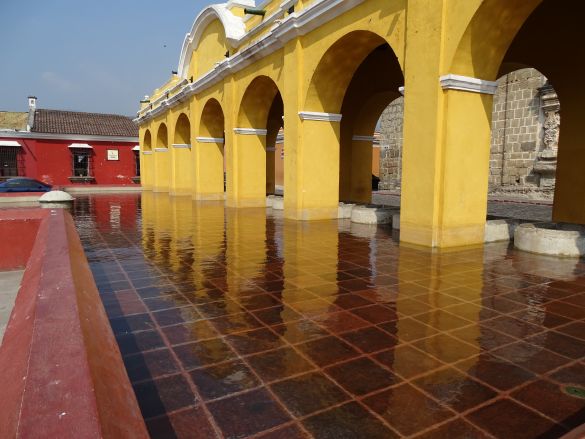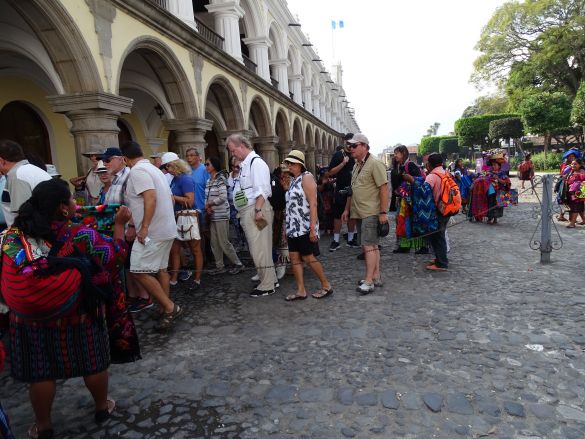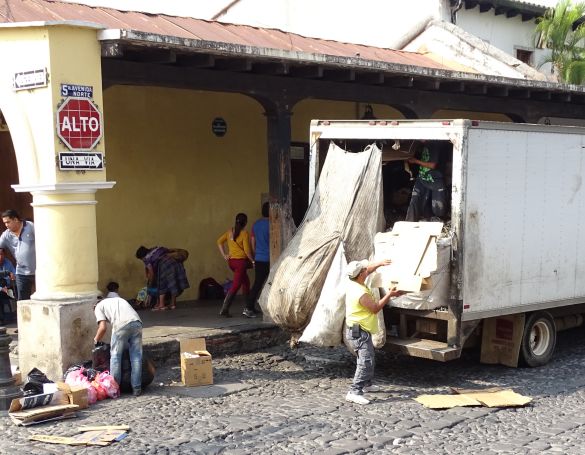De stad die in 1773 in Guatemala verwoest werd en nu
een World Heritage site is, was het bestuurlijk centrum
van Spanje in hun koloniën in Centraal- en Zuid-Amerika.
Daarmee is Antigua eigenlijk vooral als concept, als idee,
van belang en veel minder als materieel erfgoed.
Dat materieel erfgoed is er maar beperkt aanwezig.
Of dat voor Batavia (Jakarta) ook zo is weet ik niet, want daar
ben ik nooit geweest.
Wat er veel te zien is: de aanwezigheid van de christelijke zending.
In navolging van de ontdekkingsreizigers en kolonisten kwamen de
diverse christelijke ordes naar Amerika.
Dat is te zien aan de vele kerken en kloosters in Antigua.
Niet dat er nu nog veel religieuzen aanwezig zijn. Ik verwijs
naar kerken en kloosters die er in 1773 waren en waarvan de
restanten en ruïnes nu nog te zien zijn.
Een voorbeeld daarvan is de Franciscaanse kerk, met heiligdom, museum en
de ruïnes van een kloostercomplex. In 1525 werd begonnen aan de bouw.

Dit is het uitzicht vanaf het plein voor de kerk (Iglesia de San Francisco) naar de stad toe.

De kerk is vandaag nog in gebruik. Er is een heiligdom en een tuin. In die tuin bijvoorbeeld deze opstanding/verrijzenis.

Centraal in het heiligdom staat het graf van Hermano Pedro de San José de Bethancourt. Een Spaanse Franciscaan die in 1667 overleed en in 2002 heilig werd verklaard.

Iglesia de San Francisco. We hebben de kerk en het heiligdom bezocht maar de ruïnes vond ik toen het interessantst.
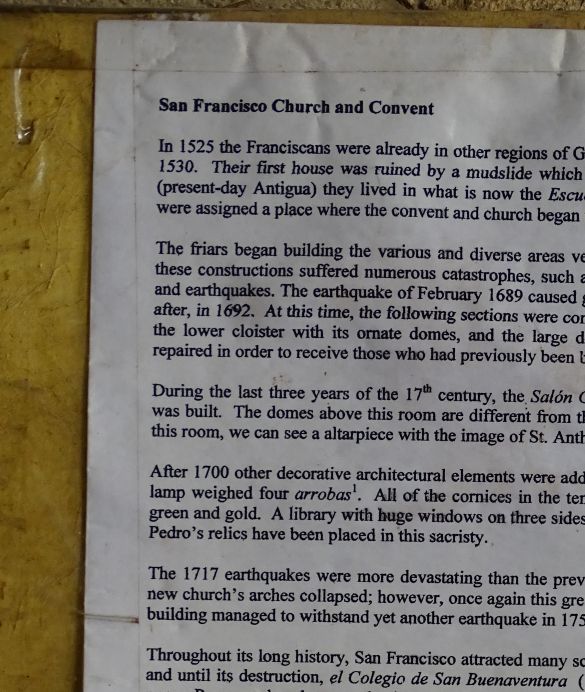
Dit is een deel van onderstaande beschrijving van de geschiedenis van het complex. De Engelse vertaling is van Barbara A. Prust.
San Francisco Church and Convent
In 1525 the Franciscans were already in other regions of Guatemala, but they remained in Almolonga until 1530.
Their first house was ruined by a mudslide which destroyed the entire city in 1541.
In Santiago (present-day Antigua) they lived in what is now the Escuela de Cristo (School of Christ), but soon after were assigned a place where the convent and church began to flourish.
The friars began building the various and divers areas very carefully.
During the subsequent centuries, these constructions suffered numerous catastrophes, such as electrical outages due to thunderstorms, fires and earthquakes.
The earthquake of February 1689 caused great devastation, but reconstruction began soon after, in 1691.
At this time, the following sections were completed: the sacristy (now part of the museum), the lower cloister with its ornate domes, and the large domes for burials.
In addition the crypts were repaired in order to receive those who had previously been buried in them, including brother Pedro.
During the last three years of the 17th century, the Salón General de los Estudios (General Study Room) was built.
The domes above this room are different from the others in the convent.
Today, in the back of this room, we can see a altarpiece with the image of St. Anthony.
After 1700 other decorative architectural elements were added.
It has been said that the main altar’s silver lamp weighed four arrobas (1 arrobas is a Spanish unit of measurement equal to 11,501 kg or 25,304 lbs).
All of the cornices in the temple were embellished with railings painted in green and gold.
A library with huge windows on three sides was built above the great sacristy.
St. Brother Pedro’s relics have been placed in this sacristy.
The 1717 earthquakes were more devastating than the previous ones.
The murals in the convent and the new church’s arches collapsed; however, once again this great convent was repaired and strengthened.
The building managed to withstand yet another earthquake in 1751, but its final destruction occurred in 1773.
Throughout its long history, San Francisco attracted many scholars and great artists.
Since the 17th century and until its destruction, el Colegio de San Buenaventura (St. Bonaventura School) had always remained open.
Renowned sculptors and painters such as Alonso de la Paz, Juan de Aguirre, and Tomás de Merlo, as well as other Franciscan artists, used to work in the Salón de Artes (The Art Room).
The Mexican artist, Cristóbal Villalpando, produced some huge paintings of the life of St. Francis for this convent, which are now on display in the Museo Colonial here in Antigua.
In addition the Franciscans possessed the second printing press brought to Guatemala.
In 1871 the friars rebuilt the Chapel of the Third Order, and in 1817 St. Brother Pedro’s tomb was placed where it remained until 1991.
The rest of the temple, as well as the convent, remained in ruins, becoming a play area for children and a home for a few families, until Antigua was declared a national monument and San Francisco consequently remained under the custody of a guardian.
In 1960, when this monument was turned over to the Franciscan Order, reconstruction with iron and concrete began, in spite of the many objections from historians, architects, structural engineers and other distinguished individuals.
The rest of the various constructions lie in ruins.
As you stroll through them and tour the museum, remember that you are stepping on the same ground where a saint once walked.
English translation by Barbara A. Prust

Zou daar het Tau-teken te zien zijn, in die stralenkrans?

De kerk was in barokstijl. Dat is hier en daar nog te zien aan ornamenten.
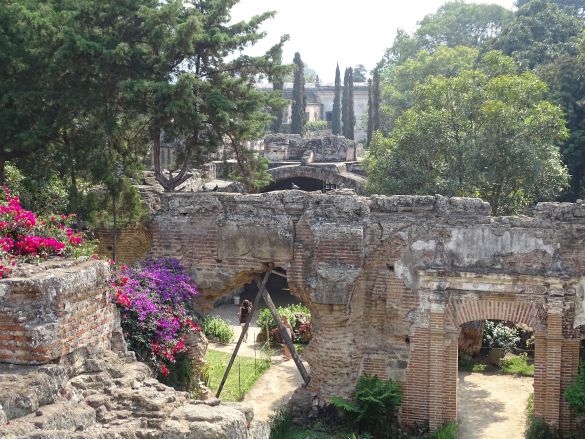
De ruïnes vormen een prachtige en vooral rustige omgeving.

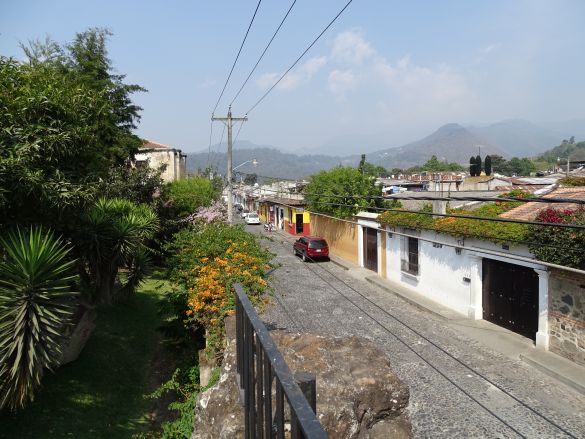
Natuurlijk grenzen de kerk en de ruïnes aan woonwijken. Het hoogteverschil is opvallend.
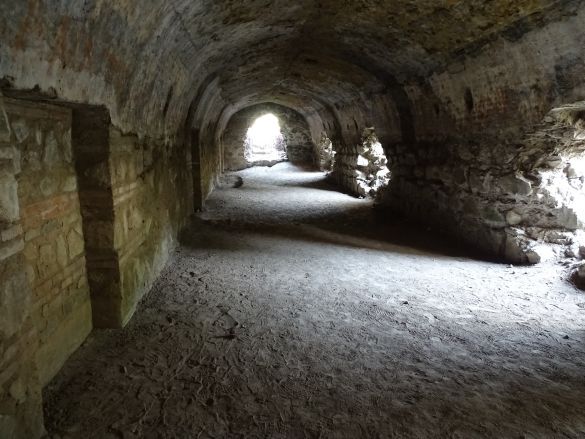

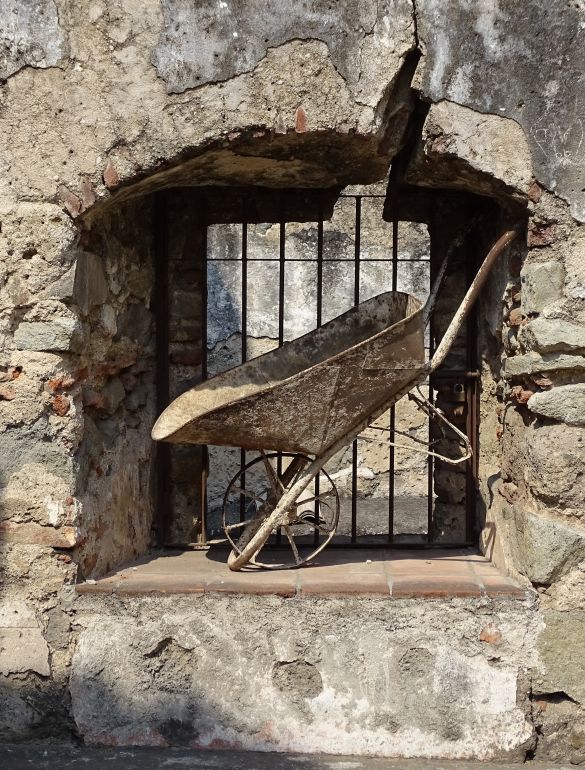


Een basis van een fontein?
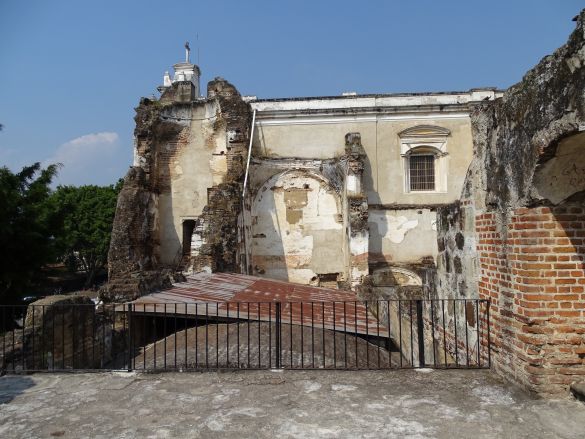
Vind-ik-leuk Aan het laden...


